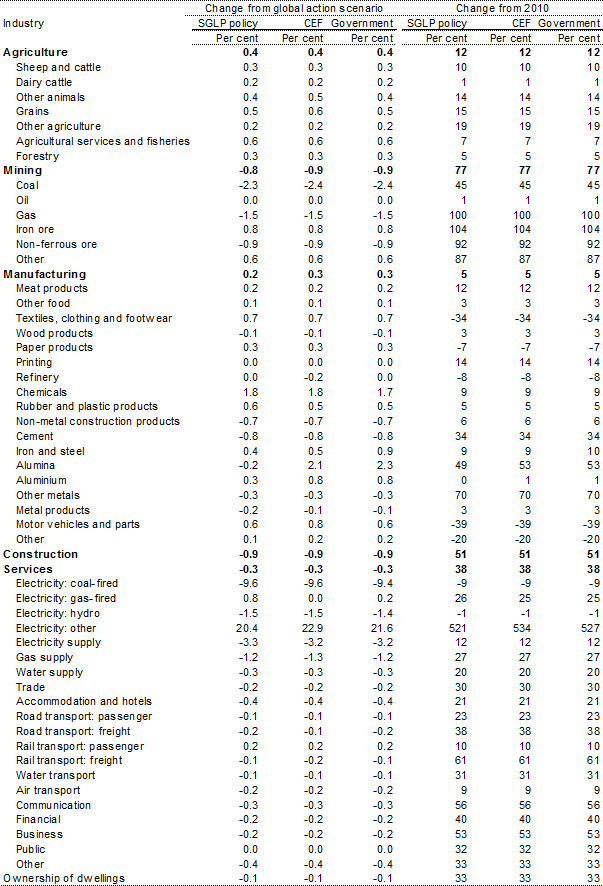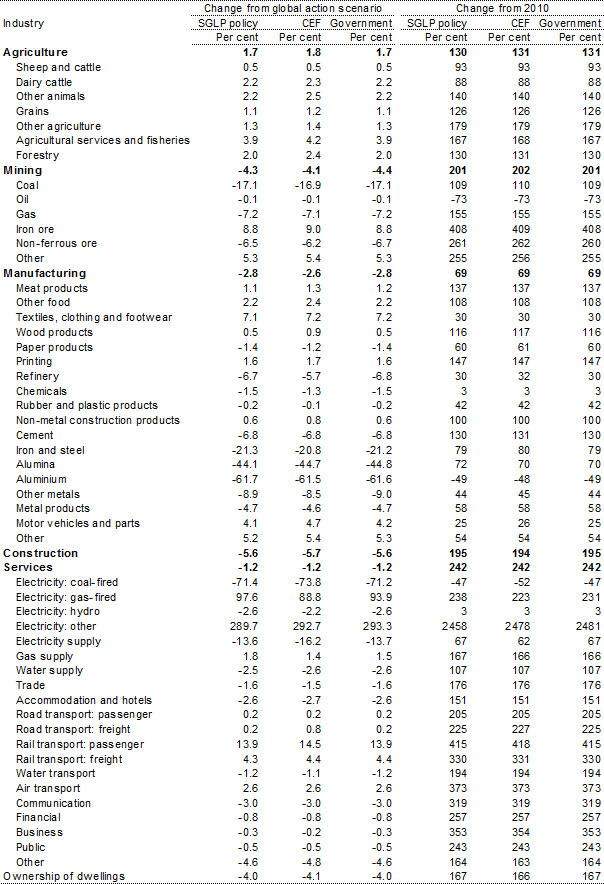The Australian economy will continue to prosper as we reduce emissions. The two updated policy scenarios have very similar aggregate economic outcomes to the SGLP policy scenario because differences in the carbon price for the first three years and other policy features are small.
Real average incomes continue to grow at rates only slightly below those without carbon pricing. In both updated policy scenarios, gross national income (GNI) per person in today’s dollars will rise by $9,000 to 2020 and by more than $30,000 to 2050. From 2010 to 2050, GNI per person grows at an average annual rate of 1.1 per cent with carbon pricing compared with 1.2 per cent without carbon pricing.
Gross domestic product (GDP) in today’s dollar grows from $1.3 trillion now to over $1.7 trillion in 2020 and to around $3.6 trillion in 2050. Similarly, employment continues to grow strongly, with 1.6 million jobs created by 2020 and 6 million jobs by 2050, with or without carbon pricing. These results are consistent across all policy scenarios.
Carbon pricing affects the composition of the Australia economy. Structural changes due to carbon pricing in the updated policy scenarios are similar to the SGLP policy scenario. Over time, resources shift from emission‑intensive to low or less emission‑intensive industries and processes, although this shift is smaller than the structural change from other factors such as the high terms of trade, ageing population, changes in tastes and the ongoing expansion of Asian economies.
Under all policy scenarios, all state economies grow strongly with carbon pricing and emissions are reduced significantly from where they otherwise would be. Effects on individual states vary reflecting the carbon intensity of their economies. Carbon pricing slows growth by no more than 0.1 of a percentage point per year to 2050, and in some states — South Australia, Tasmania and Victoria — the effect is even smaller. Data at a sufficient level of detail and quality is not available to reliably quantify the impact of carbon pricing at a sub‑state regional level, which would require detailed projections of movements of resources between regions, and between industries within regions.
Australia’s GNI is higher in the Government scenario than in the Clean Energy Future scenario. This is because the additional domestic abatement sourced from heavy on‑road transport is cheaper than sourcing abatement overseas. The effective carbon price on fuel used by heavy on‑road transport also has a small impact on the growth of the road freight industry to 2050.
Different policy settings to the SGLP scenario also directly affect two industries. The steel industry benefits from additional assistance in the Government scenario, so it grows slightly more strongly over the period to 2020. The alumina industry also grows slightly more strongly to 2020 in both updated policy scenarios because the cap on transitional assistance to emission‑intensive trade‑exposed industries assumed in the SGLP scenario no longer affects it.
Table 3: Gross output, by industry, 2020

Source: Treasury estimates from MMRF.
Note: CEF is an abbreviation for Clean Energy Future.
Table 4: Gross output, by industry, 2050

Source: Treasury estimates from MMRF.
Note: CEF is an abbreviation for Clean Energy Future.
Box 1: Recent developments in the steel industry
The SGLP report projects that Australia’s manufacturing sector continues to grow over the next decade, but at a slow rate. Resources continue to be drawn from the manufacturing sector to support growth in services, construction and mining. This structural adjustment continues the long‑term shift of resources in the Australian economy seen over recent years. The historically high exchange rate, associated with high commodity prices and strong growth in mining exports as investment comes on line, accelerates this trend over the next decade.
Since the SGLP report, participants in the steel industry have announced plans to restructure their operations, including deactivating one Port Kembla blast furnace. They have made it very clear that their proposed restructure is in no way attributable to the introduction of a carbon price, and is instead driven by factors such as the exchange rate, high input prices, excess supply capacity on global markets and slowing global demand for steel products. The restructure is being conducted in a way that ensures facilities can be reactivated in the event of a sustained improvement in steel markets that enables profitable sales to resume.
The medium global action reference scenario has not been updated to incorporate these recent announcements. To the extent the restructuring would have a similar impact on both the reference case and the policy scenarios — given it is unrelated to the introduction of carbon pricing — updating the modelling to include the restructuring would not affect findings about the effects of carbon pricing on the economy.
Given the unique set of challenges facing the Australian steel industry, in July the Government announced the Steel Transformation Plan to provide $300 million of assistance over five years from 2012‑13. The Steel Transformation Plan encourages investment and innovation in steel manufacturing and helps the sector become more efficient and sustainable in a low carbon economy. More recently, in August this year, the Government announced the introduction of a new advance facility as part of the Steel Transformation Plan to further support Australian jobs and to help ensure the future of the Australian steel industry.